Related Research Articles

The Battle of Iwo Jima was a major battle in which the United States Marine Corps (USMC) and United States Navy (USN) landed on and eventually captured the island of Iwo Jima from the Imperial Japanese Army (IJA) during World War II. The American invasion, designated Operation Detachment, had the purpose of capturing the island with its two airfields: South Field and Central Field.

The Battle of Lake Trasimene was fought when a Carthaginian force under Hannibal ambushed a Roman army commanded by Gaius Flaminius on 21 June 217 BC, during the Second Punic War. The battle took place on the north shore of Lake Trasimene, to the south of Cortona, and resulted in a heavy defeat for the Romans. War had broken out between Rome and Carthage early in 218 BC. Hannibal, ruler of the Carthaginian territories in south-east Iberia, marched an army through Gaul, crossed the Alps and arrived in Cisalpine Gaul later that year. The Romans rushed reinforcements north from Sicily but were badly defeated at the Battle of the Trebia.

The Tenth United States Army was the last army level command established during the Pacific War during World War II, and included divisions from both the U.S. Army and the U.S. Marine Corps.

The Fleet Marine Force Combat Operation Insignia is a miniature 5⁄16 inch bronze United States Marine Corps emblem that may be authorized by the Secretary of the Navy for wear on specific campaign, expeditionary, and service medal ribbons issued to United States Navy sailors attached to and on duty with Fleet Marine Force (FMF) units during combat operations and sailors on duty with Navy units attached to and operating with Fleet Marine Force units while under Marine Corps operational control during combat operations. The device was instituted in 1953 with the Navy and Marine Corps Award Manual dated 1953.

The 4th Marine Division is a reserve division in the United States Marine Corps. It was raised in 1943 for service during World War II, and subsequently fought in the Pacific against the Japanese. Deactivated after the war, the division was re-formed in 1966 and elements of the division deployed during the Gulf War in 1990–1991, as well as during the Iraq War. It is currently the ground combat element of the Marine Forces Reserve and is headquartered in New Orleans, Louisiana, and has units throughout the United States.
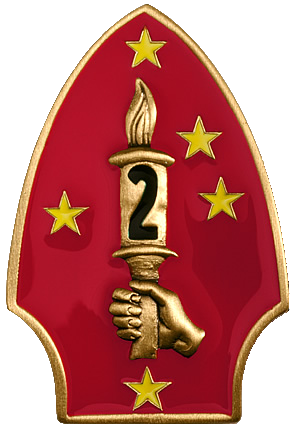
The 2nd Marine Division is a division of the United States Marine Corps, which forms the ground combat element of the II Marine Expeditionary Force. The division is based at Marine Corps Base Camp Lejeune, North Carolina and headquartered at Julian C. Smith Hall.

The 1st Marine Regiment is an infantry regiment of the United States Marine Corps based at Marine Corps Base Camp Pendleton, California. The regiment is under the command of the 1st Marine Division and the I Marine Expeditionary Force. The 1st Marine Regiment is also sometimes referred to as "Regimental Combat Team 1" or "Inchon".

Merritt Austin Edson, Sr., known as "Red Mike", was a Major General in the United States Marine Corps, First President of the Marine Corps War Memorial Foundation and First Commissioner of the Vermont Department of Public Safety & Vermont State Police.

Marine Fighter Attack Squadron 211 (VMFA-211) is a United States Marine Corps fighter attack squadron, currently consisting of F-35B Lightning II stealth STOVL strike fighter jets. Known as the "Wake Island Avengers" and the "Bastion Defenders", the squadron is based at Marine Corps Air Station Yuma, Arizona and falls under the command of Marine Aircraft Group 13 (MAG-13) and the 3rd Marine Aircraft Wing.
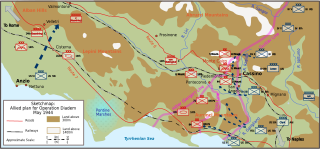
Operation Diadem, also referred to as the Fourth Battle of Monte Cassino or, in Canada, the Battle of the Liri Valley, was an offensive operation undertaken by the Allies of World War II in May 1944, as part of the Italian Campaign of World War II. Diadem was supported by air attacks called Operation Strangle. The opposing force was the German 10th Army.
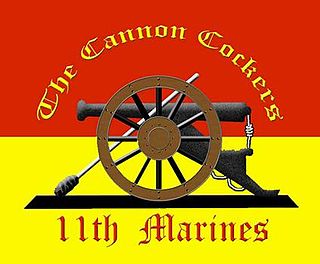
The 11th Marine Regiment is an artillery regiment of the United States Marine Corps based at Marine Corps Base Camp Pendleton, California. Known as the "Cannon Cockers", the regiment falls under the command of the 1st Marine Division and the I Marine Expeditionary Force. Its primary weapon system is the M777A2 howitzer with a maximum effective range of 30 km, however the 5th Battalion has converted to fire the HIMARS weapon system.

2nd Battalion, 3rd Marines (2/3) was an infantry battalion in the United States Marine Corps based out of Marine Corps Base Hawaii consisting of approximately 1,000 Marines and sailors. The battalion fell under the command of the 3rd Marine Regiment and the 3rd Marine Division. The battalion was deactivated in January 2022 as part of the Marine Corps' ongoing Force Design efforts.
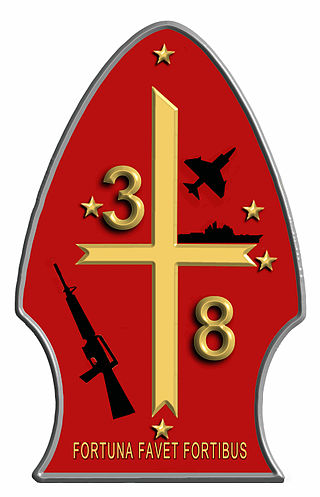
3rd Battalion 8th Marines (3/8) was an infantry battalion in the United States Marine Corps based out of Marine Corps Base Camp Lejeune, North Carolina, was consisted of approximately 1,100 Marines and Sailors. The battalion fell under the command of the 8th Marine Regiment and the 2nd Marine Division.
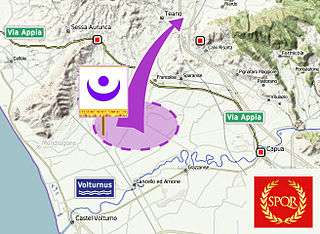
The Battle of Ager Falernus was a skirmish during the Second Punic War between the armies of Rome and Carthage. After winning the Battle of Lake Trasimene in Italy in 217 BC, the army commanded by Hannibal marched south and reached Campania. The Carthaginians ultimately moved into the district of Falernum, a fertile river valley surrounded by mountains.

Francis Junior Pierce was a United States Navy hospital corpsman in World War II who received the nation's highest military decoration for valor, the Medal of Honor. He was awarded the medal for heroic actions "above and beyond the call of duty" on March 15–16, 1945, while assigned to a Marine Corps infantry battalion during the Battle of Iwo Jima.

The Trasimene Line was a German defensive line during the Italian Campaign of World War II. It was sometimes known as the Albert Line. The German Commander-in-Chief (C-in-C), Generalfeldmarschall Albert Kesselring, used the line to delay the Allied northward advance in Italy in mid June 1944 to buy time to withdraw troops to the Gothic Line and finalise the preparation of its defenses.
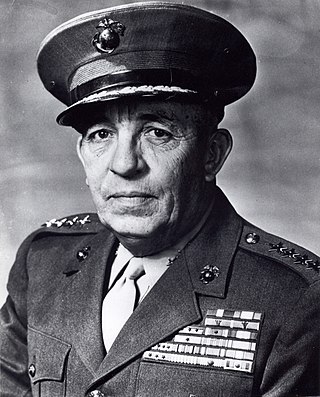
Edwin Allen Pollock was a United States Marine Corps General and a highly decorated combat veteran of World War II and Korea; he commanded both the 1st and 2d Marine Divisions and is the only man to have served as commanding general of both the Atlantic and Pacific Fleet Marine Force. He had been advanced to the rank of general upon retirement by reason of having been specially commended in combat.
Hispanics in the United States Marine Corps, such as Private France Silva who during the Boxer Rebellion became the first Marine of the thirteen Marines of Latin American descent to be awarded the Medal of Honor, and Private First Class Guy Gabaldon who is credited with capturing over 1,000 enemy soldiers and civilians during World War II, have distinguished themselves in combat. Hispanics have participated as members of the United States Marine Corps in the Boxer Rebellion, World War I, the American intervention in Latin America also known as the Banana Wars, World War II, the Korean War, the Vietnam War, the Gulf War and most recently in the military campaigns of Afghanistan and Iraq.

The Battle of Shewan was a military engagement between Coalition forces and Taliban insurgents that took place on August 8, 2008, near the village of Shewan in the Bala Buluk district, Farah Province, Afghanistan.

The Marine Raider Regiment (MRR), formerly known as the Marine Special Operations Regiment (MSOR), is a special operations force of the United States Marine Corps, which is a part of Marine Corps Special Operations Command (MARSOC). Renamed for its predecessor, the World War II Marine Raiders, this unit is the principal combat component of MARSOC, which is the Marine Corps' contribution to the United States Special Operations Command (USSOCOM).
References
- U.S. Marine Corps (1 March 2007). Marine Corps Operations. Cosimo, Inc. pp. 7–. ISBN 978-1-60206-062-3.